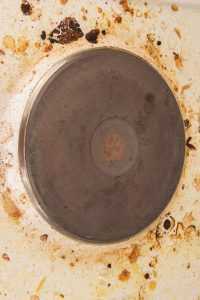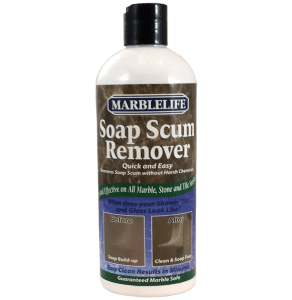The right Is it DIRTY or DAMAGED? Why Your Cleaning Efforts Fail.
The right answer to the wrong problem still fails. Just because it looks dirty doesn’t mean that best cleaner is going to be successful….if its actually damaged. So how can you tell the difference?
With stone – if its rough when it should be smooth – it’s damaged. If you are trying to clean off a white spot, ring or spill mark from your marble – it’s damaged. If your grout is stained, and no matter what you do its not coming clean – yup damaged. Just looks dirty.
That said, we still have the answers. MARBLELIFE has been researching “Clean” for 25 years, and developing the restorative solutions needed to repair damage so it CAN be kept clean.
Once clean, the causes of dirt are often the causes for damage. So sand, dirt and dust are the abrasive material necessary to abrade, wear and damage your marble floor. Appropriate matting outside and inside to knock dirt off of shoes can extend the life of your floor and its finish for years…not to mention its clean appearance. Yes taking off shoes will help as well.
Spills, acidic juices and even acid rain can dissolve marble surfaces leaving pesky white spots that look like they go away when you clean them, only to return when dry. Yup, water filled in the dissolved holes allowing light to reflect off the surface and look new only to evaporate back to leave an empty white spot.
So what do you do? Try and clean it. If it fails, reach out for a FREE estimate. Marblelife is happy to evaluate your floors, provide guidance on what is happening, how to avoid it, and if necessary how to restore a beautiful appearance.
So what is the difference between cleaning, polishing and restoring? Cleaning is removing the oil and dirt that has collected on your floors. An effective de-greasing non-acidic non-abrassive cleaner is a start, provided it does not introduce or deposit any waxes. MARBLELIFE is formulated to fit the bill.
Polishing seeks to either to apply a sacrificial topical that can fill in MICRO damaged areas. Most floors today have a hard coat, much like your car that is designed to provide chip resistance and durability. Many flooring products do as well, though each are different, and they are not created equally. This is why we see some cleaners seek to “cheat” by introducing a little wax to make it look glossy … and clean… when in reality they just deposited a wax which will now trap dirt and eventually build up and become hazy. Wrong answer, creating a bigger problem later. The right material will be a reactive that bonds to the original hard coat and reacts. Here again, dangerous on the wrong hands. Janitorial staffs have confused treatments designed for one purpose as gloss enhancers and become notorious for layering on so much chemical that the floor can no longer breath. Yes – your floor must breath. If your house is sitting on the ground moisture is seeking to move through the surface, and when it encounters a barrier will find and push itself through the week point. (Hopefully you are not recognizing your situation here). So what is one to do? If your floor needs to be polished, call a professional restoration company. If the cause is wax buildup related it will require stripping to get back to the natural finish. If the floor is suffering micro-wear abrasion it will need a light restorative polishing. If the floor has heavy wear it will need to be restored.
Restoration required the floor to rehoned, ground flat if you will so that light can once again bounce true off its surface. Once complete the surfaces appears clean and glossy and can once again be maintained with a cleaner. Now you are back to cleaner selection and matting to reduce wear.
In all cases, one cannot talk about floors without talking about grout. All issues resolve around grout sealing. If sealed dirt cannot get into it. If not grout is a dirt sponge. If sealed with a penetrating sealer, it will eventually need to be resealed, either because someone introduced an acidic cleaner, or spilled an acidic food or drink on it. In either case, what was sealed is now unsealed. What once was protected is now soaking up dirt, and the very act of cleaning the tile surface is transferring dirt INTO the grout line. Vinegar is NOT the answer. It is acidic and accelerates the removal of the seal, plus can leach the dye color from your grout…making it lighter but for the wrong reasons. MARBLELIFE has developed a class of acid resistant colorizeable sealers that can be quickly professionally applied to address this issue, restore a uniform clean appearance, and most importantly provide a non-acid sensitive seal. Its so effective, the market expects grout to trend towards a standard gray, and have color introduced via the sealer, as this enables the sealer to verify the seal via the color uniformity. Bottomline, if your grout is stained, while powerwashing might improve the situation, it will not become as clean as new, until this root cause is addressed. Again a call to MARBLELIFE and you are a step closer to a cleaner home, life and less frustrated situation.
Once the root cause has been addressed, and an APPROPRIATE cleaner safe for your surface selected, cleaning is really easy. That said, just because the product says you should use it on a surface does not mean it is not causing a problem. This is the most inconvenient truth, and one that frustrates every truly knowledgeable professional, as they know that most restoration damage is self inflicted with the use of a well marketed inappropriate cleaner.
Every seen a commercial for hard water removal from tile? Restoration businesses soar everytime these adds run, as people bring on an acidic cleaner and damage their grout and marble.
MARBLELIFE’s products are formulated to remove dirt and grime safely and easily. If our products don’t give you satisfaction, call us, we would be happy to provide an assessment of what is happening. Odds are we can get your surface “clean,” and make your life and your cleaning much easier and satisfying.

 Most people would answer clean, and quite correctly. Waxes tend to scuff, buff and trap dirt. That might be okay when you have made the choice to use them, but when they are passed off as a cleaner, and they seek to equate gloss with clean. There is a problem. Even worse, when you realize that in order to recreate that gloss you need to use the product again. In fact, much more frequently than if the floor was wax-free.
Most people would answer clean, and quite correctly. Waxes tend to scuff, buff and trap dirt. That might be okay when you have made the choice to use them, but when they are passed off as a cleaner, and they seek to equate gloss with clean. There is a problem. Even worse, when you realize that in order to recreate that gloss you need to use the product again. In fact, much more frequently than if the floor was wax-free. In defense of Men… The grout around the toilet is pretty disgusting. All you ladies know what I am talking about, and you all know EXACTLY how it happened… Poor aim.
In defense of Men… The grout around the toilet is pretty disgusting. All you ladies know what I am talking about, and you all know EXACTLY how it happened… Poor aim.
 Do you know the first thing a professional tile restorer will do to eliminate stained grout? Apply a mild acid. This is done in order to REMOVE the seal before applying a new seal. This makes sense ONLY if you are planning on applying the new seal, then subsequently an ideally non-acidic sensitive seal. As you can see, use of an acidic cleaner on a grout floor cannot be a good idea. Sure it provides a lighter stain, giving the appearance of being cleaner, but one has just opened the floor to actually accepting stains more easily. Oops! And it gets worse! Because clearly the marketer wants you to use more of their cleaner.
Do you know the first thing a professional tile restorer will do to eliminate stained grout? Apply a mild acid. This is done in order to REMOVE the seal before applying a new seal. This makes sense ONLY if you are planning on applying the new seal, then subsequently an ideally non-acidic sensitive seal. As you can see, use of an acidic cleaner on a grout floor cannot be a good idea. Sure it provides a lighter stain, giving the appearance of being cleaner, but one has just opened the floor to actually accepting stains more easily. Oops! And it gets worse! Because clearly the marketer wants you to use more of their cleaner. Remember Mom telling us “if you did it right the first time, you wouldn’t have to waste time doing it again?” I certainly do. Perhaps this is why we focus so much on understanding why we had to do it the first time rather than seeking to eliminate the root cause. (Wait a minute though, we aren’t referring to getting rid of the pets, kids or even the husband). Actually, we’re talking about how many cleaners result in a lot of wasted time. It’s more prevalent than one might expect. It’s akin to the planned obsolescence of the 1970 car market. Where cars were designed to fail, so you needed to buy a new one. Cleaners are designed to be marketed versus functional. We want shiny – so waxes are added to impart shine (But hold the phone! They also attract and hold dirt, but that’s okay they’ll buy more.) I very much hate that. I want to be done fast and easy and in as little time as possible. I want is done RIGHT so I don’t have to keep doing it again.
Remember Mom telling us “if you did it right the first time, you wouldn’t have to waste time doing it again?” I certainly do. Perhaps this is why we focus so much on understanding why we had to do it the first time rather than seeking to eliminate the root cause. (Wait a minute though, we aren’t referring to getting rid of the pets, kids or even the husband). Actually, we’re talking about how many cleaners result in a lot of wasted time. It’s more prevalent than one might expect. It’s akin to the planned obsolescence of the 1970 car market. Where cars were designed to fail, so you needed to buy a new one. Cleaners are designed to be marketed versus functional. We want shiny – so waxes are added to impart shine (But hold the phone! They also attract and hold dirt, but that’s okay they’ll buy more.) I very much hate that. I want to be done fast and easy and in as little time as possible. I want is done RIGHT so I don’t have to keep doing it again.

 WILL YOUR MARBLE & TRAVERTINE CLEANER MAKE YOUR LIFE EASIER, SAFER AND HEALTHIER?
WILL YOUR MARBLE & TRAVERTINE CLEANER MAKE YOUR LIFE EASIER, SAFER AND HEALTHIER? Bleach, though a popular choice as a disinfectant, does not actually clean, and is only a moderate disinfectant. The version of bleach commonly sold for cleaning is a much more diluted form of Sodium Hypochlorite and as such, is not the best disinfectant. Weak or insufficient contact with disinfectants result in bacteria and viruses that develop immunity to the disinfectant. Failure to fully eradicate a bacterium when treating for it, whether with an antibiotic or a cleaner, allows the organism to potentially develop a defense or immunity, just as humans do after getting sick. Ineffective disinfection is credited with being a major contributor in the rise of super bugs and secondary-infection-related deaths in hospitals across the country. Few people consider this same situation exists in homes across the country -even though we are not concentrating various ill-stricken individuals within closed quarters, increasing the odds of encountering a nasty bug). If one is looking for an effective disinfectant, consider what MARBLELIFE recommends to its service providers when cleaning and restoring bathrooms: Vital Oxide (available at
Bleach, though a popular choice as a disinfectant, does not actually clean, and is only a moderate disinfectant. The version of bleach commonly sold for cleaning is a much more diluted form of Sodium Hypochlorite and as such, is not the best disinfectant. Weak or insufficient contact with disinfectants result in bacteria and viruses that develop immunity to the disinfectant. Failure to fully eradicate a bacterium when treating for it, whether with an antibiotic or a cleaner, allows the organism to potentially develop a defense or immunity, just as humans do after getting sick. Ineffective disinfection is credited with being a major contributor in the rise of super bugs and secondary-infection-related deaths in hospitals across the country. Few people consider this same situation exists in homes across the country -even though we are not concentrating various ill-stricken individuals within closed quarters, increasing the odds of encountering a nasty bug). If one is looking for an effective disinfectant, consider what MARBLELIFE recommends to its service providers when cleaning and restoring bathrooms: Vital Oxide (available at 


